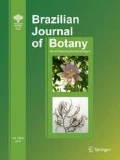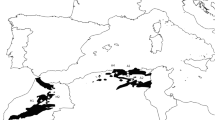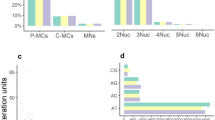Abstract
Ameroglossum (Scrophulariaceae) is an endemic genus from northeastern Brazil patchily distributed in granitic rock outcrops (inselbergs) with two species described: the endangered A. pernambucense Eb. Fischer, S. Vogel & A. V. Lopes and the narrow endemic A. manoel-felixii L. P. Felix & E. M. Almeida. We developed 15 polymorphic nuclear microsatellite markers for A. pernambucense using pyrosequencing and successfully cross-amplified 14 of these loci in A. manoel-felixii and a taxonomically uncertain taxon (a putative Ameroglossum hybrid). The number of alleles per loci ranged from 2 to 6, 2 to 5 and 2 to 6 in the examined populations of A. pernambucense, A. manoel-felixii and the putative hybrid, respectively. No significant linkage disequilibrium was detected, and significant deviation from Hardy–Weinberg equilibrium was found in some loci, likely reflecting inbreeding and population structure across inselbergs. We discuss the use of these SSR markers in conservation and microevolutionary studies in Ameroglossum, as well as in the investigation of the importance of pollen-mediated gene flow in keeping genetic diversity in rare species with patchily distributed populations using progeny arrays.
Similar content being viewed by others
References
Almeida EM, Wanderley AM, Nollet F et al (2016) A new species of Ameroglossum (Scrophulariaceae) growing on inselbergs in Northeastern Brazil. Syst Bot 41:423–429. doi:10.1227/NEU.0b013e318201c293
Barbará T, Martinelli G, Fay MF et al (2007) Population differentiation and species cohesion in two closely related plants adapted to neotropical high-altitude “inselbergs”, Alcantarea imperialis and Alcantarea geniculata (Bromeliaceae). Mol Ecol 16:1981–1992. doi:10.1111/j.1365-294X.2007.03272.x
Boisselier-Dubayle MC, Leblois R, Samadi S et al (2010) Genetic structure of the xerophilous bromeliad Pitcairnia geyskesii on inselbergs in French Guiana—a test of the forest refuge hypothesis. Ecography (Cop) 33:175–184. doi:10.1111/j.1600-0587.2009.05446.x
Ellstrand NC, Elam DR (1993) Population genetic consequences of small population size: implications for plant conservation. Annu Rev Ecol Syst 24:217–242. doi:10.1146/annurev.ecolsys.24.1.217
Excoffier L, Laval G, Schneider S (2005) Arlequin (version 3.0): an integrated software package for population genetics data analysis. Evol Bioinform Online 1:47–50
Fischer E, Vogel S, Lopes AV (1999) Ameroglossum, a new monotypic genus of Scrophulariaceae-Scrophularioideae from Brazil. Feddes Repert 110:4–9
Frankham RJ, Ballou JD, Briscoe DA (2002) Introduction to conservation genetics. Cambridge University Press, Cambridge
Grivet D, Sork VL, Westfall RD, Davis FW (2008) Conserving the evolutionary potential of California valley oak (Quercus lobata Née): a multivariate genetic approach to conservation planning. Mol Ecol 17:139–156. doi:10.1111/j.1365-294X.2007.03498.x
Guichoux E, Lagache L, Wagner S et al (2011) Current trends in microsatellite genotyping. Mol Ecol Resour 11:591–611. doi:10.1111/j.1755-0998.2011.03014.x
Martins WS, Lucas DCS, Neves KF, Bertioli DJ (2009) WebSat—a web software for microsatellite marker development. Bioinformation 3:282–283
Millar MA, Coates DJ, Byrne M (2014) Extensive long-distance pollen dispersal and highly outcrossed mating in historically small and disjunct populations of Acacia woodmaniorum (Fabaceae), a rare banded iron formation endemic. 961–971. doi:10.1093/aob/mcu167
Pinheiro F, Cozzolino S, Draper D et al (2014) Rock outcrop orchids reveal the genetic connectivity and diversity of inselbergs of Northeastern Brazil. BMC Evol Biol 14:49. doi:10.1186/1471-2148-14-49
Slatkin M (1987) Gene flow and the geographic structure of natural populations. Science 236:787–792. doi:10.1126/science.3576198
Vieira MLC, Santini L, Diniz AL, de Munhoz CF (2016) Microsatellite markers: what they mean and why they are so useful. Genet Mol Biol 39:312–328. doi:10.1590/1678-4685-GMB-2016-0027
Wanderley AM, Almeida EM, Felix LP (2014a) Ameroglossum pernambucense. In: IUCN Red List Threat. Species. http://www.iucnredlist.org/details/56726171/0. Accessed 6 Oct 2016
Wanderley AM, Lopes AV, Machado IC (2014b) Reproductive ecology of Ameroglossum pernambucense (Scrophulariaceae): is this ornithophilous and threatened shrub highly adapted to a naturally fragmented habitat? Plant Syst Evol 300:1099–1110. doi:10.1007/s00606-013-0948-x
Weising K, Nybom H, Wolff K, Kahl G (2005) DNA fingerprinting in plants: Principles, methods and applications. CRC Press, Boca Raton
Wright S (1921) Systems of mating. Genetics 16:111–178
Acknowledgements
Authors are thankful to Fundação de Amparo à Ciência e Tecnologia do Estado de Pernambuco (FACEPE), Coordenação de Aperfeiçoamento de Pessoal de Nível Superior (CAPES) and Conselho Nacional de Desenvolvimento Científico e Tecnológico (CNPq 470806/2011-7) for financial support.
Author information
Authors and Affiliations
Corresponding author
Rights and permissions
About this article
Cite this article
Wanderley, A.M., Vasconcelos, S., Huettel, B. et al. Development of 15 SSR polymorphic markers for the endangered Ameroglossum pernambucense Eb. Fischer, S. Vogel & A. V. Lopes (Scrophulariaceae), and cross-transferability in congeneric taxa. Braz. J. Bot 40, 1007–1011 (2017). https://doi.org/10.1007/s40415-017-0410-3
Received:
Accepted:
Published:
Issue Date:
DOI: https://doi.org/10.1007/s40415-017-0410-3




